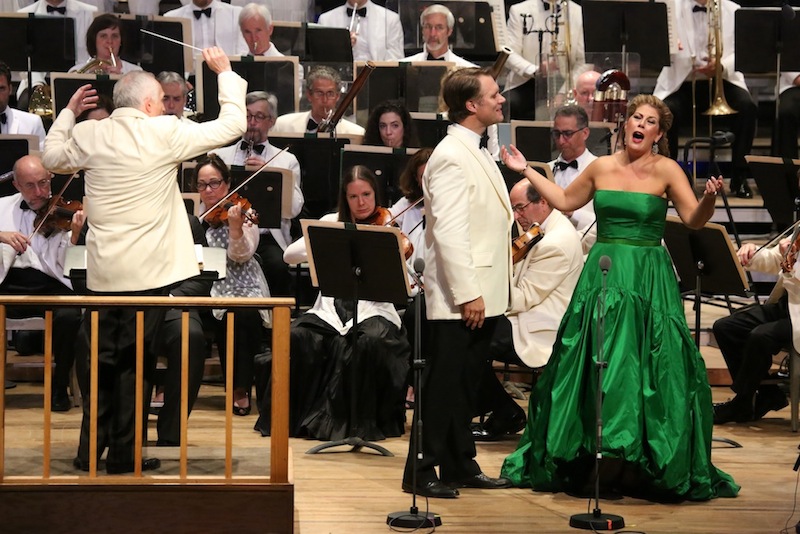Starry vocalists strike sparks in night of Verdi and Puccini at Tanglewood

Brandon Jovanovich and Sondra Radvanovsky perform Act 1 of Puccini’s “Tosca” with Bramwell Tovey and the BSO Saturday night at Tanglewood. Photo: Hilary Scott
Tosca, Puccini’s “shabby little shocker,” unfolds in a twisted plot of seduction, murder, torture, and suicide. Yet the work brims with a rich lyricism that makes it one of the composer’s most popular stage works.
Saturday night, Bramwell Tovey led the Boston Symphony Orchestra and a starry lineup of guest singers in a sparkling account of Act 1 of the drama, continuing a storied tradition of concert opera at Tanglewood.
Much of the lyricism of the first Act falls to the lead characters, Cavaradossi, played by tenor Brandon Jovanovich, and Tosca, sung in grand style by Sondra Radvanovsky.
The soprano, who currently enjoys a high-profile career, brought a rich, amber tone to the role. Her upper register has power as well as clarity, and as an actress, her portrayal of the jealous songstress was colorful and vividly characterized. Tosca’s despair when she fears that her lover Cavaradossi may be cheating on her was fully manifest. The love scene between Tosca and the painter was affecting as Radvanovsky and Jovanovich performed with poignant chemistry.
Jovanovich was a short-notice stand-in for Gwyn Hughes Jones, who had to bow out of the Saturday’s performance due to a visa-related issue. The tenor proved a terrific replacement, singing with smooth-toned voice that brought inviting warmth to the part. His rendering of “Recondita armonia” drew immediate and much-deserved applause.
Bryn Terfel was bold and menacing as the conniving Scarpia. His singing was aptly dark and only grew darker as he formulated his plot to capture Cavaradossi and possess Tosca. His singing of “Va, Tosca” was ominous, and when he joined the chorus for the final phrases of the Te Deum, the effect was mesmerizing.
Filling out the cast was a solid array of singers. Bass-baritone John Del Carlo was a humorous presence as the Sacristan, and as Angelotti, Ryan Speedo Green sang with a rich, resonant bass voice.
The Tanglewood Festival Chorus, directed by John Oliver, and Voices Boston, prepared by Andy Icochea Icochea, sang with zest and energy to bring bright sounds the score.
Tovey led a muscular account of the piece that allowed Puccini’s music to flower. The orchestra answered with playing of sturdy power and emotional intensity.
That commitment also characterized the first half of the concert, which consisted of music by Verdi.
Before donning his bad boy image as Scarpia, Bryn Terfel appeared as soloist in two operatic excerpts, the heartrending “Ella giammai m’amò” from Don Carlos and “Ehi! paggio! . . . L’onore” from Falstaff.
Terfel’s take on King Philip’s lonely soliloquy was deep and mournful, his tone like a mighty oak swaying in the orchestral wind.
The BSO handled the sparse scoring that opens the aria with finesse. Martha Babcock’s solo cello added a tinge of yearning to the steely sound of the winds and strings.
In the Falstaff excerpt, Terfel found the comedic persona of the brazen rotund knight, slapping his knee and tugging at Tovey’s suit jacket while singing with clarion tone and punctuating the piece with snarls and growls. Tovey was in command of it all, drawing stirring support from the orchestra.
The meat of the first half, Verdi’s Stabat Mater, featured the fine singing of the Tanglewood Festival Chorus.
Published in 1898 as one of four sacred works, the Stabat Mater is a richly dramatic setting of the Medieval Latin prayer, which tells of Mary’s sorrow at the foot of the cross at Christ’s crucifixion.
To capture the emotion of this most poignant of texts, the singers lofted their lines with supple blend and pristine diction.
A few isolated phrases in the beginning of the work suffered from some untidy attacks, but as the piece progressed the singers’ confidence grew. “Vidit suum” was desolate, the chorus controlling the thin textures with delicacy to match the sweet melancholy of the verse.
Tovey coaxed weighty, determined playing from the orchestra to support the earth-shaking statements of the “Sancta Mater.” “Flammis ne urar succensus” exploded with power. But the most affecting moment came at the end where the phrases of “Paradisi gloria” seemed to float heavenward where they formed into chords of robust strength before tapering off to whispers for the final “Amen.”
Tovey’s reading of popular curtain raiser, the overture to La forza del destino, was equally solid.
The conductor took the stirring music that opens the work at a brisk tempo, drawing playing of precision and bounce from the musicians. Solo winds and strings floated gracefully in the sparsely textured music that followed while the principal theme churned like waves in the trombones and basses.
Posted in Performances
Posted Jul 13, 2015 at 3:43 pm by Paul Pesenti
Once again, the Pesenti family on vacation, thrilled to another Tanglewood spectacular, graced by the talents of so many luminaries. We were especially entranced by the radiant voice of Sondra Rodvanovsky (first time hearing her “live!”) This was also our first Verdi Stabat Mater. (My wife, a choral director, was quick to pick up on the “untidy entrances” at spots. I totally missed it, but your review confirms her “good-ear,” Mr. Keebaugh, and she confirms yours, though we are quick to dismiss this minor flaw by the overall excellence of the choral performance of difficult and unfamiliar music. We are all impressed that the choral performance is memorized–a level of expertise not always required on the classical stage! Terfel’s Falstaff alone was worth the price of admission!